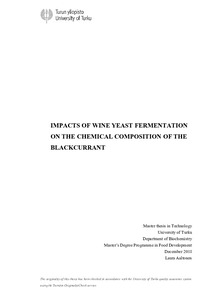Impact of wine yeast fermentation on the chemical compositions of the blackcurrant
Aaltonen, Laura (2018-12-28)
Impact of wine yeast fermentation on the chemical compositions of the blackcurrant
Aaltonen, Laura
(28.12.2018)
Julkaisu on tekijänoikeussäännösten alainen. Teosta voi lukea ja tulostaa henkilökohtaista käyttöä varten. Käyttö kaupallisiin tarkoituksiin on kielletty.
avoin
Julkaisun pysyvä osoite on:
https://urn.fi/URN:NBN:fi-fe201901172481
https://urn.fi/URN:NBN:fi-fe201901172481
Tiivistelmä
Grapes are the most commonly used raw material in the wine making. If wines are made from other fruits than grapes, they are called fruit wines. Blackcurrant is the second most cultivated berry in Finland. The fermentation of wine is usually made with Saccharomyces yeasts, but use of non-Saccharomyces yeasts has been an increasing trend in the past few years. The chemical composition thus the overall quality of the wine depends on the yeast used.
The goal of the study was to investigate the effects of Saccharomyces and non-Saccharomyces yeasts on the chemical quality of the blackcurrant wine. Five different yeasts were used to ferment blackcurrant juice: two S. cerevisiae, one S. bayanus, one Torulaspora delbrueckii and two Metschinikowia species. Metschinikowia-yeasts were sequentially inoculated with two S. cerevisiae yeasts. The sugars, organic acids and alcohols in the samples were analysed with GC-FID methods and the flavonols and anthocyanins with HPLC-DAD methods.
Differences were found between the yeasts and the most interesting from sequential inoculations. The sequential inoculation consumed fructose and glucose more effectively from wines than pure fermentation. Galacturonic acid was only detected in the sequential. The Saccharomyces yeasts did consume total sugars more effectively than other yeasts. Ethanol concentration was lower in the sequential inoculation samples than in samples fermented with one yeast. S. cerevisiae and the S. bayanus yeasts had the highest concentrations of ethanol. The total flavonols compound quantity increased during the sequential inoculation fermentations. Different species and strains of yeasts have effect on the chemical quality of the blackcurrant.
The goal of the study was to investigate the effects of Saccharomyces and non-Saccharomyces yeasts on the chemical quality of the blackcurrant wine. Five different yeasts were used to ferment blackcurrant juice: two S. cerevisiae, one S. bayanus, one Torulaspora delbrueckii and two Metschinikowia species. Metschinikowia-yeasts were sequentially inoculated with two S. cerevisiae yeasts. The sugars, organic acids and alcohols in the samples were analysed with GC-FID methods and the flavonols and anthocyanins with HPLC-DAD methods.
Differences were found between the yeasts and the most interesting from sequential inoculations. The sequential inoculation consumed fructose and glucose more effectively from wines than pure fermentation. Galacturonic acid was only detected in the sequential. The Saccharomyces yeasts did consume total sugars more effectively than other yeasts. Ethanol concentration was lower in the sequential inoculation samples than in samples fermented with one yeast. S. cerevisiae and the S. bayanus yeasts had the highest concentrations of ethanol. The total flavonols compound quantity increased during the sequential inoculation fermentations. Different species and strains of yeasts have effect on the chemical quality of the blackcurrant.
